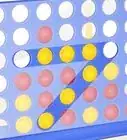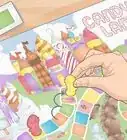This article was co-authored by wikiHow staff writer, Hunter Rising. Hunter Rising is a wikiHow Staff Writer based in Los Angeles. He has more than three years of experience writing for and working with wikiHow. Hunter holds a BFA in Entertainment Design from the University of Wisconsin - Stout and a Minor in English Writing.
This article has been viewed 53,253 times.
Learn more...
Blokus is a strategy game for 2-4 players where you try to lay down as many of your tiles on the board as you can. When you play a tile, you must place it so it touches a corner on at least one of your other pieces. Once you play as many tiles as you can, count the tiles that you weren’t able to place to determine the winner. While Blokus is an easy game to learn and play, it can take a little bit of time to master!
Steps
Learning the Basic Rules
-
1Gather all the pieces of a single color. Choose 1 of the 4 colors to use throughout the game and take all 21 colored tiles of that color. The tiles are between 1-5 squares large and vary in shape. Organize the tiles in front of you from smallest to largest so you can easily see what shapes you have to use.
- If you’re playing a 2-player game, each player will play as 2 different colors. One player chooses blue and red while the other player chooses yellow and green.
- If you’re playing a 3-player game, players alternate placing tiles for the unused color.
- You can also play as teams of 2 if you want to work cooperatively.
-
2Place one of your pieces in your corner of the game board. The turn order goes blue, yellow, red, and finally green. In turn order, choose one of your tiles in front of you and place it so it covers the corner square on the game board that’s closest to you. This is your starting corner and other pieces you play will branch off from your starting piece.
- The piece must fit exactly in the corner of the game board. You cannot place a tile that doesn’t cover the corner square on your board.
Advertisement -
3Play tiles so they touch a corner of one of your pieces. Once it’s your turn again, choose any tile you have in front of you and place it on the game board. Set the piece onto the board so one of its corners touches a corner on the first tile you placed. Make sure the tile doesn’t touch sides with any piece that’s the same color, or else it’s an illegal move.[1]
- You can rotate and flip the piece into whatever orientation you want as long as it doesn’t touch sides with another one of your pieces.
-
4Continue taking turns until you can’t play any more tiles. Go around the board and place 1 tile at a time during your turn. Make sure all of your pieces are connected to a corner of at least one other piece or else the piece doesn’t count. When a player places their last tile or when players can’t make any more moves, the game ends.
- It’s okay if your tile touches the edges of a piece that’s differently colored.
- You cannot overlap tiles on the board.
Warning: Once a piece is played on the board, you cannot move or reposition it. Choose your plays carefully!
-
5Count how many points you earn or lose to declare a winner. If you played all of your pieces, give yourself 15 points total at the end of the game. If you still have tiles in front of you when the game ends, you'll end up with a negative score. To calculate your negative score, count the number of unit squares on each tile you haven't played, and subtract that number from 0. The player with the highest score at the end of the game wins![2]
- For example, if you have 2 tiles that have 4 squares and 1 tile that has 5 squares at the end of the game, you have -13 points.
- If you place your tile that’s 1 square large, add 5 points to your score. It doesn’t matter if you still have tiles leftover.
Strategizing Your Plays
-
1Play larger tiles earlier in the game so you aren’t stuck with them later. As the game goes on, the board will get fuller and it will be harder to place tiles. Try to use your tiles that have 5 squares earlier in the game so you have room to play them and spread out on the board.[3]
- You lose 5 points for every tile with 5 squares at the end of the game, so getting rid of them will increase your score.
Tip: Save your 1- or 2-square pieces for the end of the game since you only have a few of them and they’ll be able to fit on the board better.
-
2Place tiles toward the center of the board so you have more options. At the start of the game, try to place tiles that reach toward the center of the board. If you have control of the center of the board, then you have more opportunities and space to play the rest of your tiles. Use your long 5-square tiles to get to the middle of the board and spread your pieces.[4]
- If you don’t work toward the center in the beginning, you may get stuck in a corner and have a lot of tiles leftover at the end of the game.
- Avoid playing near the edges too early in the game since you might get blocked easily.
-
3Block the corners of your opponents’ pieces so they can’t play off of them. During your turn, see if you can block the corners of your opponents’ pieces with the edges on your tiles. That way, you stop from playing more pieces and block off an area of the board. Try to block off as many of your opponents’ pieces as you can so you have control of the board.[5]
- Be careful when you place your piece since your opponents will be looking for ways to block you as well!
-
4Make multiple paths so you always have a place to play tiles. Spread out your tiles as much as you can on the board so you have a choice each turn where you can play. Uses pieces that have a lot of corners near the middle of the board so you have options to pick from. This way, you still have a place to lay a tile if your opponent blocks one of your paths.[6]
Community Q&A
-
QuestionCan my piece be touching corners of an other color's piece (besides my color's corners)?
 Community AnswerYes. Your piece can touch any part of other colored blocks, but only the corners of your own color.
Community AnswerYes. Your piece can touch any part of other colored blocks, but only the corners of your own color. -
QuestionWhat do we do if we're out of blocks?
 Community AnswerWait until the rest of the players run out of blocks, then tally the score.
Community AnswerWait until the rest of the players run out of blocks, then tally the score. -
QuestionDo I set up the board differently for three players?
 Community AnswerNo, you do not.
Community AnswerNo, you do not.
References
- ↑ https://youtu.be/CdqP6G1YtIY?t=15
- ↑ https://youtu.be/Yw8pK6Ak5oE?t=39
- ↑ https://tesera.ru/images/items/1554/notice-blokus-classic-en.pdf
- ↑ https://tesera.ru/images/items/1554/notice-blokus-classic-en.pdf
- ↑ https://tesera.ru/images/items/1554/notice-blokus-classic-en.pdf
- ↑ https://tesera.ru/images/items/1554/notice-blokus-classic-en.pdf
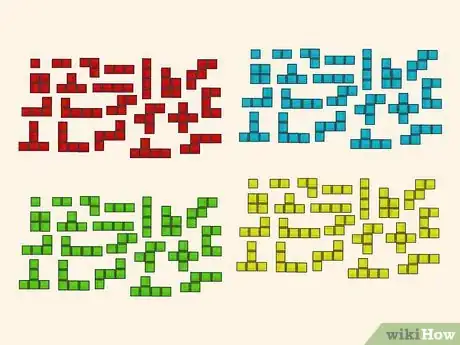


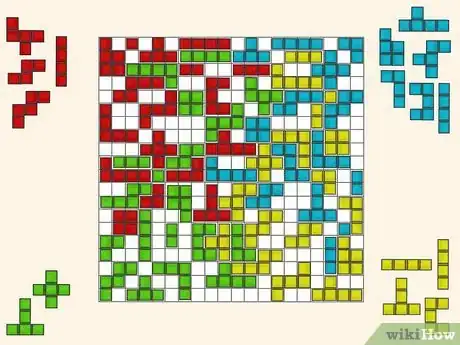
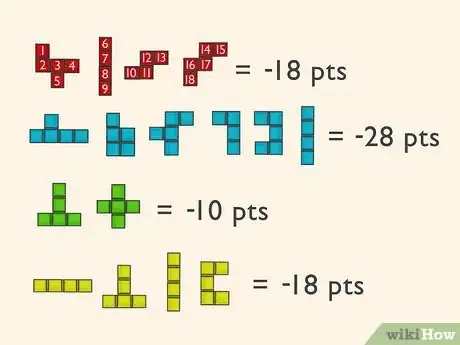


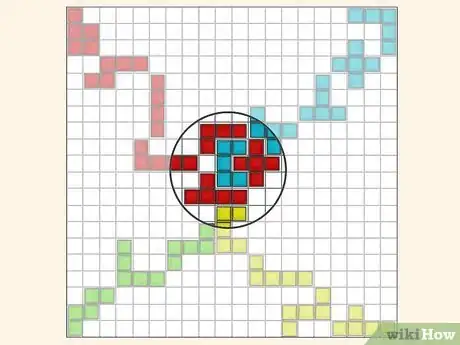
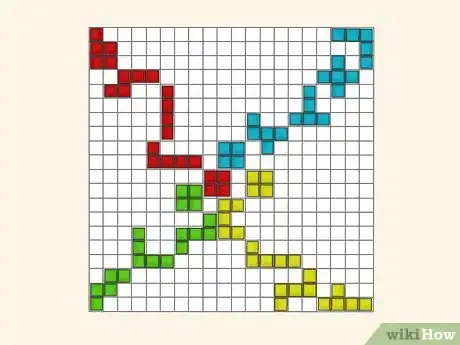





-Step-10-Version-2.webp)









